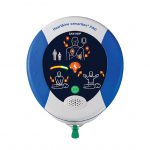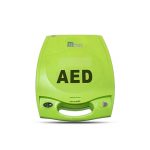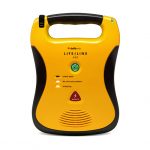HEARTSINE SAMARITAN 350P AED | Malaysia | AUTOMATED EXTERNAL DEFIBRILLATOR
ORGANIZATIONS equipped with Heartsine Samaritan aed in Malaysia










ORGANIZATIONS equipped with Heartsine Samaritan aed in Malaysia







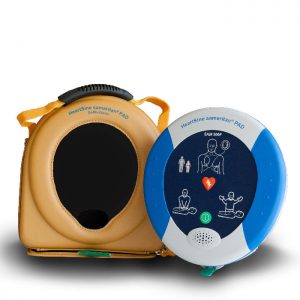
HEARTSINE SAMARITAN 350P
- Overview
- Specification
The AED HeartSine Samaritan PAD 350P was designed especially for use in public areas by providing a sophisticated defibrillator for adult or paediatric use, lightweight, compact and easy-to-operate system; from professional responders, to untrained lay rescuer.
The Heartsine Samaritan PAD 350P is one of the lightest AEDs, weighing only 1.1kg and has one of the highest industry’s IP ratings against dust and moisture. This AED has a combined battery and pad pak that expires at the same time which is 4 years, making replacement orders a breeze.
- CPR Support: Quality CPR Feedback with metronome to guide during CPR process
- Manufacturer’s Warranty: 8 years
- IP Rating: IP56
- Electrode / Pads Life: 4 years
- Battery Life: 4 years
- Energy Protocol (J): Adult: 150J – 150J – 200J
- Paediatric Technology: Requires paediatric pads
- Battery Type: Lithium Manganese Dioxide
- Weight of unit (kg): 1.1kg
- Dimensions (cm): 20 x 18.4 x 4.8
WHY CHOOSE HEARTSINE 350P
6 REASONS TO CHOOSE HEARTSINE'S AED COMPARE TO OTHER DEFIBRILLATOR IN THE MARKET
Simple to Operate
Every HeartStart OnSite comes ready-to-rescue. The device is pre-installed in the carrying case and battery and pads are pre-installed in the device. Simply pull the handle on the front of the AED to activate it.
Quick Shock Feature
CPR is even more vital to survival than previously realized. Rapidly delivering shock after chest compressions is critical. The HeartStart OnSites Quick Shock feature reduces the time between hands-off and shock delivery.
Visual Queues iCONS
The HeartStart OnSites graphics-based visual instructions are designed to communicate instantly, with minimum reading and interpretation. Users not fluent in the devices language can follow easily.
Guided Audio Instruction
The HeartStart OnSite provides on-demand audio coaching. Calm, clear voice instructions are tailored to the responders actions, providing AED and CPR guidance during the resuscitation of a sudden cardiac arrest victim.
Built-in Self Test
Your HeartStart OnSite goes through a 120-point test before it leaves the factory. On the job, it conducts self tests every single day, not just weekly. It performs over 80 different tests in all. Even the pads are tested for readiness.
Integrated SMART Pads
The pads are "smart" because they can sense that they have been removed from the cartridge and applied to the patient. This helps the HeartStart OnSite know at what point the user is in the response process.
ABOUT HEARTSINE
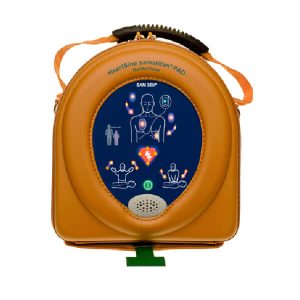
HeartSine Technologies advances the deployment of lifesaving defibrillation therapy for the treatment of sudden cardiac arrest in non-traditional areas of care.
HeartSine® was founded in 1998 to continue innovative development of advanced lifesaving products for the treatment of Sudden Cardiac Arrest. Our passion to innovate began in 1967, when we invented the first mobile defibrillator and changed the way the world delivered emergency care. In the years since, HeartSine has continued its passion to innovate by advancing mobile defibrillation and lifesaving technology.
By providing technologically advanced, easy-to-use, affordable AEDs for public access and home markets, HeartSine continues to provide medical devices that save lives.
HeartSine’s product, the samaritan® PAD (Public Access Defibrillator), which is designed for use by rescuers of all skill levels, has been deployed in thousands of facilities. HeartSine AED products are currently available in over 30 languages and are poised to save lives in more than 70 countries.
Being the technology leader in the global AED industry enables us to offer the best of all worlds in the clinical performance, durability and cost of ownership of AEDs. As a result of HeartSine’s leadership position, the HeartSine samaritan PAD is recognized around the world for lifesaving technology.
Inventor, Innovator, Lifesaver – HeartSine aims to make lifesaving pure and simple.
Powerful features and functions of HeartSine AED 350P
Advanced Technology.
Easy-to-follow Visual and Verbal Guides
User-friendly. The samaritan PAD 350P features easy-to-understand visual and voice prompts that guide a user through the process including CPR coaching.
Two-button operation. Only two buttons ON/OFF and SHOCK, are required for straightforward operation.
Always ready. A System Status Ready Indicator flashes to show that the complete system is operational and ready for use. The device automatically runs self-check each week.
Two parts, one expiry date
HeartSine’s unique Pad-Pak combines the battery and electrode pads into a single cartridge, with one expiration date to monitor.

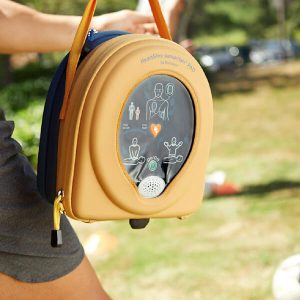
Smallest and lightest
Fully functional AED on the market, so it’s most convenient unit to use and store.
Fastest shock delivery
The HeartSine AED uses an intelligent pre-charging mechanism that minimizes the time required to analyze the ECG, detect and confirm the presence of a shockable rhythm and to charge the AED in readiness for a life-saving defibrillation shock.
From turn on (and pads attached):
- Samaritan 350P < 12 seconds
- Samaritan 500P < 12 seconds
- All advise shock < 8 seconds after CPR
.
Advanced SCOPE Biphasic Technology
The HeartSine AED utilizes proprietary electrode technology, advanced and stable firmware, and proprietary SCOPETM Biphasic Technology (an escalating and low-energy waveform that automatically adjusts for patient impedance differences) to assess rhythm and recommend defibrillation if necessary.
Most Durable – IP56
The HeartSine AED resists shock and vibration and carries an IP56 Rating, the industry’s highest rating against dust and water for an AED. It also carries an 8-year unit warranty.
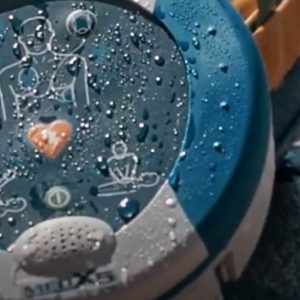
TOUGHEST AED IN THE MARKET WITH HIGHEST IP RATING IP56
HeartSine Samaritan AED Programs exclusively with cert academy

free pad pak program
If you have used a HeartSine® samaritan® PAD during a Sudden Cardiac Arrest (SCA) in a public setting, it’s critical that you TELL US, by providing HeartSine with the Saver EVO™ file.

FORWARD HEART
Forward Hearts lets survivors of a sudden cardiac arrest event pay it forward and potentially save another life by donating an AED to the organization of the survivor’s choice.

AED MAINTENANCE
Too busy to check and maintain your existing AED(s)? Worry that your AED unusable when an emergency case arise? No worries, we’re here to provide inspection and regular maintenance.
8 YEARS WARRANTY ON PAD & BATTERY
The only AED brand that offers three to five years better than industry standards
With a 8-year product warranty, the Samaritan PAD is the best backed AED on the market, today. This protection is three to five years better than industry standards and only solidifies HeartSine’s commitment to providing you with excellent protection. The Samaritan 350P is the only mainstream device with a perfect regulatory history, giving you peace of mind and comfort knowing your AED is well thought out, safe, and reliable.
WHY DO YOU NEED AUTOMATED EXTERNAL DEFIBRILATOR?
Automated External Defibrillator (AED) increase the chances of survival rate up to 75%
In a sudden cardiac arrest emergency, time is of essence. It takes an average of 8-12 minutes for first responders to arrive at the scene after 999 is called, which is why having an AED in the workplace could make the difference between life and death. There are a few downsides to having an AED in your workplace.
Who CAN USE an AED? Learn with CERT Academy on how to operate aed effectively
Because AEDs are portable, they can be used by non medical people, such as police, fire service personnel, flight attendants, security guards and others who have been properly trained to operate them. An AED operator must know how to recognize the signs of a sudden cardiac arrest, when to activate the EMS system, and how to do CPR – so it’s also vital that they receive formal training on the AED model they will use so that they become familiar with the device and are able to successfully operate it in an emergency. The American Heart Association recommends that anyone who lives or works where an AED is available for use by lay rescuers participate in Basic First Aid, CPR & AED training. AEDs, in fact, are so user-friendly that untrained rescuers can generally succeed in attaching the pads and delivering shocks. Untrained rescuers, however, may not know when to use an AED, and they may not use an AED safely, posing some danger of electric shock to themselves and others. Also, untrained rescuers may not know how to respond to the victim when the AED prompts “no shock indicated”.
FILL IN THE FORM

FREE PDF – AED Buyer’s Guide
OTHER AED DEVICES WE ARE OFFERING
AED HEARTSINE 500P
Top-tier AED comes with CPR Advisor and uses an Impedance Cardiogram (ICG) to accurately assess CPR effectiveness.
Phillips HeartStart FRx
weighs in at only 1.5kg, the most mobile AED devices available in the market. This unit also has Ingress Protection ratings (IP55)
Zoll AED Plus
Designed in vivid green outer casing, weighs 3.1kg and has high industry’s IP ratings (IP55) against dust and moisture.
Defibtech LifeLine DDU 100
Light AEDs in the industry; weighing 1.9kg. This unit is built durable with a high dust and water resistance (IP54).
FREQUENTLY ASKED QUESTION AUTOMATED EXTERNAL DEFIBRILLATOR (AED)
Sudden cardiac arrest (SCA) occurs unexpected and without warning. This is due to cessation of electrical activity that causes an irregular heartbeat, also known as arrhythmia. The heart will be unable to pump blood to the brain, heart, lungs and to the rest of the body, causes the person to collapse and become pulseless. The victim is clinically dead and will remain so if the victim does not receive treatment immediately.
A heart attack occurs when part of the heart’s blood supply is reduced or blocked, causing the heart muscle to become injured or die. This is due to a build-up of fat and cholesterol, called plaque. This process is known as atherosclerosis. If the blocked artery is not reopened quickly, the part of the heart normally nourished by that artery begins to die.
A heart attack is when blood flow to the heart is blocked resulting in the death of the heart muscle, and sudden cardiac arrest is when the heart malfunctions and suddenly stops beating unexpectedly. A heart attack is a circulation problem and sudden cardiac arrest is an electrical problem. Sometimes a heart attack can also trigger a sudden cardiac arrest.
An AED stands for Automated External Defibrillator. It is a portable device that checks the heart rhythm and can send an electric shock to the heart. The shock can stop an irregular rhythm and allow the heart to resume to normal heart rhythm.The heart must be defibrillated as soon as possible, because a victim’s chance of survival may drop by 7 to 10 percent for every minute a normal heartbeat isn’t restored.
AED is an easy-to-operate device that can be used from medical personnel, trained responders and also lay rescuers.
The AED comes with pads that will be attached to patient’s bare chest. These electrodes will send information about the person’s heart rhythm to a computer in the AED and will analyse the heart rhythm to find out whether shock is needed. The rescuers will be guided with voice or visual prompts throughout the process. If shock is needed, the AED will instruct the rescuers to give shock by pressing the shock button (Semi-Auto), or will automatically deliver the shock (Fully-Auto) to the victim. Once shock is given, the rescuers just need to wait for further instructions from the AED. This device will analyse patient’s heart rhythm for every two-minutes.
AED is safe to use from medical responders to lay responders. The AED will instruct the rescuer step-by-step throughout the process;
Eg: Apply pads to patient’s bare chest
The device is also designed into the unit precisely so that non-medical responders can’t use the AED to shock someone who doesn’t need a shock. The rescuers just need to follow the instructions from the device and make sure everyone is clear from the victim before shock is delivered.
Defibrillation is the only treatment proven to restore a normal heart rhythm. The automated external defibrillator (AED) can be used to administer an electric shock which restores the normal heart rhythm. AEDs are designed to allow non-medical personnel to save lives.
Theoretically, brain death will occur within 4 – 10 minutes. Using a defibrillator as soon as possible will increase the chance of survival up to 70 percent. After 10 minutes, the chances of survival arelikely to be negligible.
CPR only buys time. It potentially gives the victim an extra time until medical team and a defibrillator arrives. Combination of CPR and AED will increase the chance of survival of the victim.
It is very unlikely. Studies show that AEDs interpret the victim’s heart rhythm more quickly and accurately than many trained emergency professionals. If the AED determines that no shock is needed, it will not allow a shock to be given.
According to American Heart Association (AHA) the AED should be in public areas such as sports arenas, office, schools, shopping malls, airports, and etc. The AHA also advocates that all police and fire and rescue vehicles must be equipped with an AED.
Yes, never withhold AED use from a person in Cardiac Arrest.
Yes, even after a victim has been successfully defibrillated, the victim is at risk of developing Ventricular Fibrillation and may collapse again. The AED will continually analyse the victim’s heart rhythm for every two minutes. The AED should be left on until medical team arrives.
No. The electrode pads remain on throughout the emergency process until medical team arrives. If the electrode pads are in their correct locations on the victim’s chest, it will not disrupt the chest compressions process.
For every passing minute, the chances of survival drop by 10%. This portable and lightweight device gives bystanders the opportunity to perform defibrillation outside the hospital while waiting for Emergency Medical Services to arrive. Hence, AEDs strengthen the Chain of Survival.
